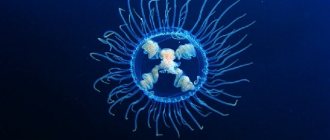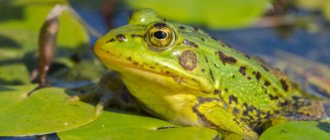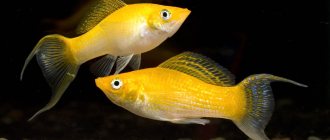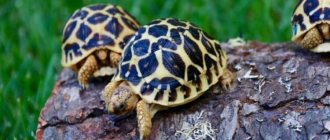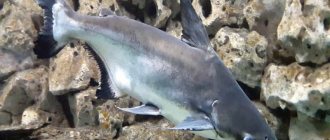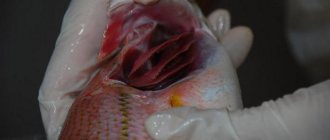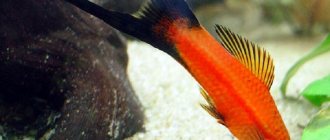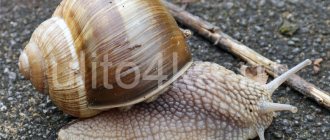- Wild animals
- >>
- Other animals
The freshwater hydra is a soft-bodied freshwater polyp that is sometimes accidentally introduced into aquariums. Freshwater hydras are inconspicuous relatives of corals, sea anemones and jellyfish. All of them are members of the phylum Cnidarians, characterized by radially symmetrical bodies, the presence of stinging tentacles and a simple gut with a single opening (gastrovascular cavity).
Origin of the species and description
Photo: Freshwater hydra
The freshwater hydra is a small polyp of the same type (cnidarians) as sea anemones and jellyfish. While most coelenterates are marine, the freshwater hydra is unusual in that it lives exclusively in fresh water. It was first described by Anthony van Leeuwenhoek (1632–1723) in a letter he sent to the Royal Society at Christmas 1702. These creatures have long been fascinated by biologists because of their ability to regenerate from small pieces.
Interesting fact: Remarkably, even cells from a mechanically separated freshwater hydra can recover and reassemble into a working animal within about a week. Scientists still do not fully understand how this process occurs.
Video: Freshwater hydra
Several species of freshwater hydras have been recorded, but most are difficult to identify without detailed microscopy. The two species, however, are distinctive.
They are the most common in our aquariums:
- Hydra (Chlorohydra) viridissima (green hydra) is a bright green species due to the presence of numerous algae called zoochlorella, which live as symbionts in endodermal cells. In fact, they are often whitish in color. Green algae carry out photosynthesis and produce sugars that are used by hydra. In turn, the hydra's predatory diet provides a source of nitrogen for the algae. Green hydras are small, with tentacles about half the length of the column;
- Hydra oligactis (brown hydra) - It is easily distinguished from other hydra by its very long tentacles, which can reach up to 5 cm or more when relaxed. The column is pale transparent brown, 15 to 25 mm long, the base is distinctly narrowed, forming a “leg”.
Lifespan
Speaking about what a hydra is, it is important to talk about the duration of the life cycle of individuals.
Back in the nineteenth century, it was hypothesized that the hydra was immortal. Over the course of the next century, some scientists tried to prove it, and some tried to refute it. Only in 1997 was it finally proven by Daniel Martinez through an experiment that lasted four years. There is also an opinion that the immortality of the hydra is associated with high regeneration. And the fact that adults die in the rivers of the central zone in winter is most likely due to a lack of food or exposure to unfavorable factors.
Appearance and features
Photo: What a freshwater hydra looks like
All freshwater hydras have a radially symmetrical bicellular layer, a tubular body separated by a thin noncellular layer called mesoglea. Their combined mouth-anus structure (gastrovascular cavity) is surrounded by protruding tentacles containing burning cells (nematocysts). This means they only have one opening in their body and that is the mouth, but it also helps get rid of waste. The body length of the freshwater hydra is up to 7 mm, but the tentacles can greatly extend and reach a length of several centimeters.
Fun fact: Freshwater hydra has tissue, but lacks organs. It consists of a tube about 5 mm long, formed by two epithelial layers (endoderm and ectoderm).
The inner layer (endoderm) lining the gastrovascular cavity produces enzymes for digesting food. The outer layer of cells (ectoderm) generates tiny stinging organelles called nematocysts. The tentacles are a continuation of the layers of the body and surround the opening of the mouth.
Due to its simple design, the body column and tentacles are highly stretchable. When hunting, the hydra straightens its tentacles, slowly moves them and waits for contact with some suitable prey. Small animals that encounter the tentacles are paralyzed by neurotoxins released from the stinging nematocysts. The tentacles wrap around the struggling prey and pull it into the widened opening of the mouth. Once the prey enters the body cavity, digestion can begin. Cuticles and other undigested debris are later expelled through the mouth.
It has a head consisting of a mouth surrounded by a ring of tentacles at one end, and a sticky disc, the foot, at the other end. Multipotent stem cells are distributed between the cells of the epithelial layers, which give rise to four differentiated types of cells: gametes, nerves, secretory cells and nematocytes - burning cells that determine the type of cnidarians.
Additionally, due to their structure, they have the ability to regulate the water inside their bodies. Thus, they can lengthen or contract their bodies at any time. Although it has no sensory organs, the freshwater hydra is responsive to light. The structure of the freshwater hydra is such that it can sense changes in temperature, water chemistry, as well as touch and other stimuli. The nerve cells of an animal are capable of being excited. For example, if you touch it with the tip of a needle, the signal from the nerve cells that sense the touch will be transmitted to the rest, and from the nerve cells to the epithelial muscle cells.
Sense organs
In the ectoderm of hydras there are stinging or nettle cells that serve for defense or attack. In the inner part of the cell there is a capsule with a spirally twisted thread.
Outside this cell there is a sensitive hair. If any small animal touches a hair, the stinging thread quickly shoots out and pierces the victim, who dies from the poison that gets along the thread. Usually many stinging cells are released at the same time. Fish and other animals do not eat hydras.
The tentacles serve not only for touching, but also for capturing food - various small aquatic animals.
Hydras have epithelial-muscle cells in the ectoderm and endoderm. Thanks to the contraction of the muscle fibers of these cells, the hydra moves, “stepping” alternately with its tentacles and its sole.
Where does freshwater hydra live?
Photo: Freshwater hydra in water
In nature, freshwater hydras live in fresh water. They can be found in freshwater ponds and slow-moving rivers, where they usually attach themselves to submerged plants or rocks. The algae living in freshwater hydra benefit from the protected, safe environment and obtain food by-products from the hydra. Freshwater hydra also benefit from algal products.
Hydras that are kept in light but otherwise starved have been shown to survive better than hydras without green algae inside them. They are also able to survive in water with low concentrations of dissolved oxygen because algae provide them with oxygen. This oxygen is a byproduct of photosynthesis carried out by algae. Green hydras pass algae from one generation to the next in their eggs.
Hydras move their bodies in the water while they are attached, expanding and contracting under a mixture of muscle movements and water (hydraulic) pressure. This hydraulic pressure is created inside their digestive cavity.
Hydras are not always attached to the substrate and can move from one place to another by sliding along the basal disk or tumbling forward. When they somersault, they detach the basal disc, then bend down and lay their tentacles on the substrate. This is followed by reattaching the basal disc before repeating the entire process again. They can also swim upside down in water. When they swim, it is because the basal disc produces a gas bubble that carries the animal to the surface of the water.
Now you know where freshwater hydra is found. Let's see what she eats.
Movement
In a calm state, the tentacles extend several centimeters. The animal slowly moves them from side to side, lying in wait for prey. If necessary, the hydra can move slowly.
"Walking" mode of transportation
"Walking" method of movement of the hydra
Having curved its body (1) and attached its tentacles to the surface of an object (substrate), the hydra pulls the sole (2) to the front end of the body. Then the walking movement of the hydra is repeated (3,4).
What does freshwater hydra eat?
Photo: Freshwater hydra polyp
Freshwater hydras are predatory and voracious.
Their foodstuffs are:
- worms;
- insect larvae;
- small crustaceans;
- larval fish;
- other invertebrates such as daphnia and cyclops.
Hydra is not an active hunter. These are classic ambush predators that sit and wait for their prey to get close enough to strike. The moment the victim is close enough, the hydra is ready to activate the reaction of caustic cells. This is an instinctive response. The tentacles then begin to curl and move towards the prey, pulling it towards the mouth at the base of the tentacle stalk. If it's small enough, the hydra will eat it. If it is too large to consume, it will be discarded, and perhaps found by a mysterious aquarist, with no apparent cause of death.
In case prey is not enough, they can obtain some food by absorbing organic molecules directly through the surface of their body. When there is no food at all, the freshwater hydra stops reproducing and begins to use its own tissues for energy. As a result, she will shrink to a very small size before finally dying.
The freshwater hydra paralyzes its prey with neurotoxins it secretes from tiny, stinging organelles called nematocysts. The latter are part of the ectodermal cells of the column, especially the tentacles, where they are packed in high density. Each nematocyst is a capsule containing a long and hollow filament. When hydra is stimulated by chemical or mechanical signals, the permeability of the nematocysts increases. The largest of these (penetrants) contain neurotoxins, which the freshwater hydra injects into its prey through a hollow thread. The smaller claws, which are adhesive, curl spontaneously upon contact with prey. It takes less than 0.3 seconds to sting the victim.
Features of character and lifestyle
Photo: Freshwater hydras
Symbiosis between freshwater hydra and algae has been shown to be very common. Through this type of association, each organism benefits from the other. For example, thanks to its symbiotic relationship with algae of the genus Chlorella, the green hydra can synthesize its own food.
This represents a significant advantage for freshwater hydra, given that they can synthesize their own food when environmental conditions change (food is scarce). As a result, the green hydra has a great advantage over the brown hydra, which lacks the chlorophyll necessary for photosynthesis.
This is only possible if the green hydra is exposed to sunlight. Although they are carnivores, green hydras are able to survive for 3 months using sugars produced through photosynthesis. This allows the body to tolerate starvation (in the absence of prey).
Although they usually plant their feet and stay in one place, freshwater hydras are quite capable of moving around. All they have to do is release their leg and swim to a new location, or move forward slowly, attaching and releasing their tentacles and foot alternately. Given their reproductive abilities, ability to move around whenever they want, and to eat prey several times their size, it is clear why freshwater hydra are not welcome in the aquarium.
The freshwater hydra's cellular structure allows this tiny animal to regenerate itself. Intermediate cells located on the surface of the body can be transformed into any other type. In the event of any damage to the body, the intermediate cells begin to divide very quickly, grow and replace the missing parts, and the wound heals. The regenerative abilities of the freshwater hydra are so high that if you cut it in half, one part will grow new tentacles and a mouth, while the other will grow a stem and sole.
Regeneration
Hydra has a very high ability to regenerate. When cut crosswise into several parts, each part restores the “head” and “leg”, maintaining the original polarity - the mouth and tentacles develop on the side that was closer to the oral end of the body, and the stalk and sole develop on the aboral side of the fragment. The whole organism can be restored from individual small pieces of the body (less than 1/100 of the volume), from pieces of tentacles, and also from a suspension of cells. Moreover, the regeneration process itself is not accompanied by increased cell division and is a typical example of morphallaxis.
Social structure and reproduction
Photo: Freshwater hydra in water
Freshwater hydra undergo two mutually exclusive modes of reproduction: in warm temperatures (18-22°C) they reproduce asexually by budding. Reproduction in freshwater hydras usually occurs by an asexual method known as "budding". The bud-like growth on the body of the "parent" freshwater hydra eventually grows into a new individual, which becomes separated from the parent.
When conditions are harsh, or there is a shortage of food, freshwater hydras can reproduce sexually. One individual can produce male and female reproductive cells, which are released into the water where fertilization occurs. The egg develops into a larva, which is covered in tiny hair-like structures known as cilia. The larva can either immediately settle down and develop into a hydra, or end up in a tough outer layer that allows it to survive in harsh conditions.
Interesting fact: Under favorable conditions (it is very unpretentious), freshwater hydra is capable of “generating” up to 15 small hydras per month. This means that every 2-3 days it makes a copy of itself. One freshwater hydra is capable of producing 4,000 new hydras in just 3 months (considering that “children” also produce 15 hydras per month).
In autumn, with the onset of cold weather, all hydras die. The mother's body decomposes, but the egg remains alive and overwinters. In the spring it begins to actively divide, the cells are arranged in two layers. With the onset of warm weather, a small hydra breaks into the egg shell and begins an independent life.
Nervous system
The nerve cells that form a network throughout the body are located in the mesoglea, and the processes of the cells extend outwards and into the body of the hydra. This type of structure of the nervous system is called diffuse. Especially many nerve cells are located in the hydra around the mouth, on the tentacles and sole. Thus, coelenterates already have the simplest coordination of functions.
Hydrozoans are irritable. When nerve cells are irritated by various stimuli (mechanical, chemical, etc.), the perceived irritation spreads throughout all cells. Thanks to the contraction of muscle fibers, the hydra's body can shrink into a ball.
Thus, for the first time in the organic world, reflexes appear in coelenterates. In animals of this type, reflexes are still monotonous. In more organized animals they become more complex during the process of evolution.
Hydra structure
Natural enemies of freshwater hydras
Photo: What a freshwater hydra looks like
In their natural habitat, freshwater hydras have few enemies. One of their enemies is the trichodina ciliate, which is capable of attacking it. Some types of sea fleas can live on her body. The free-living flatworm planaria feeds on freshwater hydra. However, you should not use these animals to fight hydra in the aquarium: for example, trichodins and planaria are the same opponents for fish as for freshwater hydra.
Another enemy of the freshwater hydra is the large pond snail. But it should also not be kept in an aquarium, as it carries some fish infections and can feed on delicate aquarium plants.
Some aquarists place hungry young gouramis in an aquarium containing freshwater hydra. Others fight it using knowledge of its behavior: they know that the hydra prefers well-lit places. They shade all but one side of the aquarium and place glass from the inside of that wall. Within 2-3 days, almost all freshwater hydra will gather there. The glass is removed and cleaned.
These small animals are very susceptible to copper ions in the water. Therefore, another method that is used to combat them is to take a copper wire, remove the insulating cover and secure the bundle over the air pump. When all the Hydras die, the wire is removed.
Body structure
Expanding the topic “What is Hydra?”, an external description of the genus should also be given.
The length of the body ranges from one millimeter to two centimeters, and sometimes a little more. The body of the hydra has a cylindrical shape, in front there is a mouth surrounded by tentacles (their number can reach twelve). There is a sole at the back, with the help of which the animal can move and attach to something. There is a narrow pore on it, through which liquid and gas bubbles are released from the intestinal cavity. The individual, together with this bubble, detaches from the support and floats up. In this case, the head is in the water column. In this way, the individual disperses throughout the reservoir.
The structure of the hydra is simple. In other words, the body is a bag whose walls consist of two layers.

